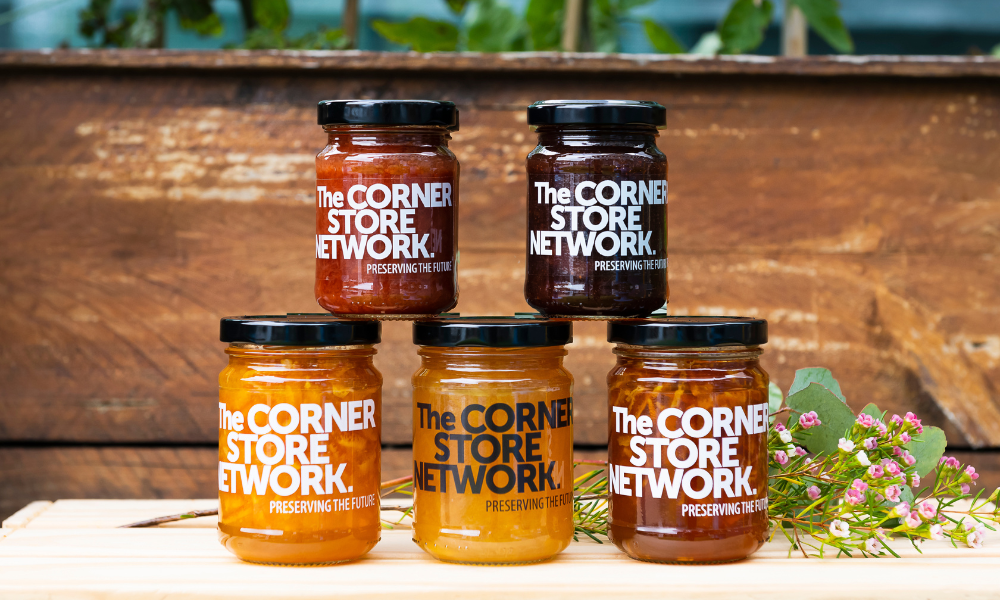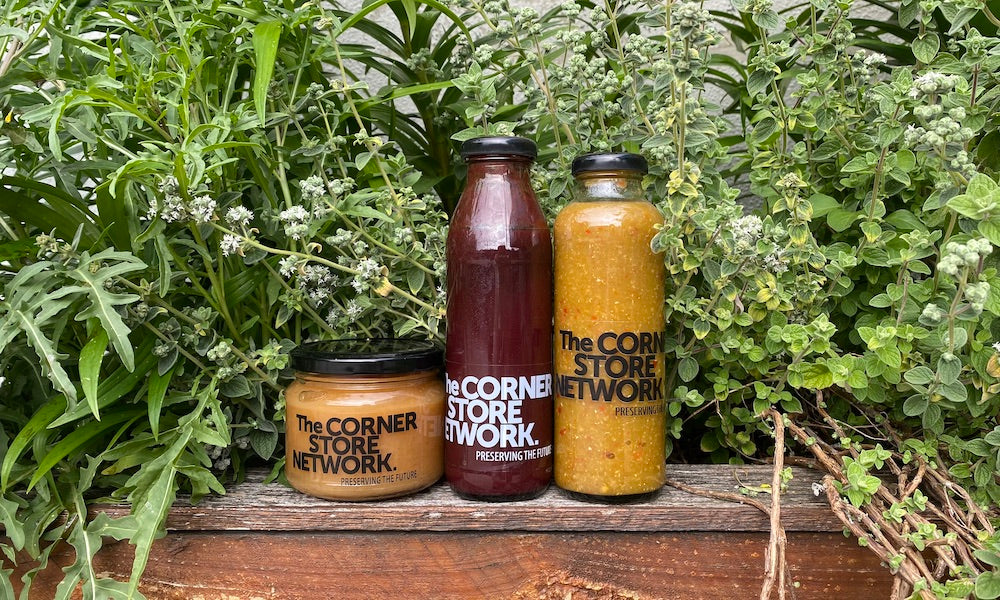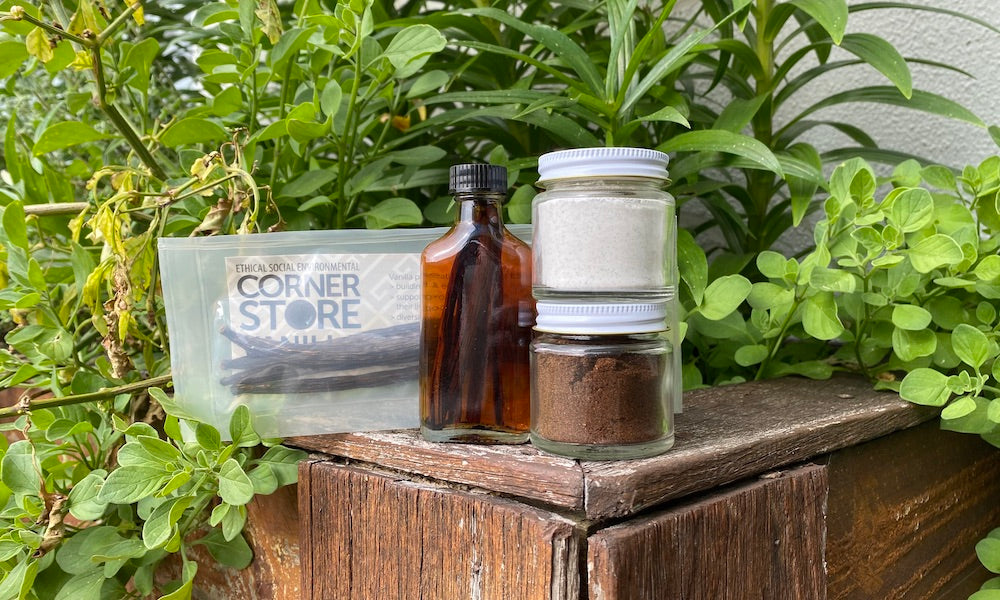If the spectrum of preserves available in our shop (and around town) makes your head explode, you’ve come to the right place! In this comprehensive guide to preserves, we break down the differences between jam and marmalade, relish and chutney, shrub and cordial plus everything in between. You’ll discover which products suit which culinary needs and how to harness each to elevate dishes from toast and baking to cocktails and gourmet nibbles!
Let’s get decoding!

THE SWEET SPREADS
Sweet spreads are used far and wide for breakfast, baking and afternoon tea, but what’s the difference between a jam, a marmalade and everything in between?
JAM
Jam is a thick, sweet spread made from crushed or chopped whole fruits. Traditional jam recipes call for fruits like strawberry, blackberry, plum and apricot but our preserving kitchen likes to push the boundaries with flavours like passionfruit, rhubarb, plum and fig. Its sweet and fruity composition makes jam the perfect spread for toast, scones and crumpets, often served with butter, peanut butter or a dollop of cream. It's also an extremely versatile baking and dessert ingredient, perfect for tarts, cakes, biscuits and slices.
Shop our handmade jam.
MARMALADE
Marmalade is a thick, chunky spread made from the juice and peel of citrus fruits. Grapefruit, orange and lemon are popular flavours, but we like to get creative with fruits like yuzu, cumquat and native lime. Tart and bitter by nature, marmalades compliment everything from toast and scones to pastries and pancakes. In cooking, marmalades work exceptionally well in glazes and marinades.
Shop our Melbourne marmalade.
JELLY
Completely smooth in consistency, a jelly is made from the juice of fruits that are high in pectin, a natural setting agent. Lemons, quince and strawberry guava all fall into this category! Jellies are great with cheese and crackers or can be added to salad dressing and sauces for a fruity hit. One thing to note is that jellies melt quickly so avoid using them with hot desserts and baking.
Shop our fruit jelly.
BUTTER
Like jelly, fruit butters are made from fruits high in pectin which are cooked down and reduced until they set. The main difference between the two is that butter contains whole fruit, whereas jelly is made only from juice. Butters also generally use less sugar than other sweet spreads. Our favourite is apple butter, which is great on tea cakes, pancakes and pork!
Shop our apple butter.
PASTE
A paste is the most concentrated type of preserve due to its low and slow cooking method. Excess liquid is cooked off to produce a lower yield but a punch of flavour, just like how tomato paste elevates savoury dishes. Fruit paste can be made from a range of fruits spanning pear to persimmon, but our favourites are quince and figs. Pastes are amazing on a cheese platter, but also can be used in a number of desserts and flaky pastries.
Shop our fig or quince paste.
CURD
A curd differs from other sweet spreads as it traditionally contains eggs, butter and far less sugar. At the Corner Store, we sub out these animal products for soy milk and rice flour to create delicious vegan curds with longer shelf lives. Popular fruits for curds are lemon, lime, grapefruit, rhubarb, passionfruit and mango. With a smooth dolloping texture, curd is perfect on top of tarts, crepes, ice cream or stirred through yoghurt.
Shop our vegan lime curd.

THE SAUCES
The terms relish and chutney are often used interchangeably, but there are a few subtle differences that might help you pick the perfect condiment in future. We’ve also thrown in an overview of one of our favourite, but lesser known, sauce varieties - the kassundi!
RELISH
A relish is usually made from a finely chopped vegetable (like tomato, cucumber, rhubarb or onion), plus lemon juice and vinegar. It’s generally smoother and thinner in consistency than a chutney and has a more pickled taste that balances smooth and sweet flavours. Relishes pair excellently with BBQ meats and toasted or fresh sandwiches.
Shop our Melbourne relish range.
CHUTNEY
A chutney is often made from a mix of fruit, vegetables, herbs and spices. It tends to be more chunky in texture but also very soft. Usually a chutney will have a balance of tangy, sweet and spicy flavours with spices like turmeric, mustard and chilli to counteract the sweetness. Chutneys work amazing with cheese and crackers, as a dip for Indian appetisers or plonked straight on top of curries.
Shop our handmade chutney range.
KASSUNDI
A kassundi is a lesser known sauce but an absolute flavour sensation. It’s similar to a relish in that it’s often made of finely chopped tomatoes (or eggplant, plums and persimmon in our kitchen!) but it’s also packed full of Indian spices like cumin, ginger and mustard to give it a spicy kick. We eat kassundi the same way we eat relish or chutney - on top of meats, as a dip for savoury baked goods, with sandwiches or atop a curry!
Shop our spicy kassundi range.

THE PICKLES
Pickles are a great way to add an acidic component to sandwiches, salads, cheese boards and drinks. Our pickles come in two varieties: salty or sweet! Which is best for you really comes down to personal preference and what flavour you’re trying to add to your dish.
SALTY
A salty pickle contains straight vinegar with spices and is predominately used when pickling vegetables like cucumber, carrots, cauliflower and onions. In our kitchen, we use a salty pickle mix for salted lime, bread and butter pickles and pickled green tomatoes. Salty pickles are an amazing addition to burgers and salads, and also pair perfectly with fried meats.
SWEET
A sweet pickle uses a mix of vinegar, sugar and spices, and can be used to pickle vegetables (like the above) but also fruit. Our sweet pickles include pickled fennel, pickled figs and pickled cumquats. They go great on cheese boards, tapas and, if you're feeling adventurous, in cocktails!
Shop our homemade pickles.

THE LIQUIDS
Sweet liquids can add a punch of flavour to water, cocktails, mocktails and even some foods! Cordials, syrups and shrubs all have distinct attributes that make them suitable for different uses - more below!
CORDIAL
While supermarket cordials are full of additives and preservatives, handmade cordials like ours are made from fruit juice, sugar, water and citric acid. A wide range of fruits can be used to make cordial, but popular flavours include lemon, lime, strawberry and black currant. We also offer unique cordial flavours like mandarin, strawberry guava and grapefruit. Cordials are an excellent way to jazz up cocktails, water and liquid based recipes like granita.
Shop our fancy cordial range.
SHRUB
A shrub is a more concentrated and vinegary version of a cordial. Shrubs often contain stone fruit, berries, tomatoes or herbs plus water and vinegar. Unlike cordials, shrubs are made by steeping rather than cooking, which means they tend to not keep as well but also the flavour can change over time. Sweet and tart, shrubs are mostly used to make interesting fruit cocktails!
SYRUP
Syrups are more concentrated and more sugary than cordials and shrubs. They are a great mixology ingredient as they can be used in place of both fruit juice and simple syrup! Because they are thicker than spirits and mixers, syrups are best used in shaken cocktails which allows them to integrate properly rather than sink to the bottom. Another surprisingly delicious use for syrups is mixing them through yoghurt for a fruity kick. Syrups can be made from many fruits but some of our favourites are fig, lemonade and cumquat.
Shop our small-batch syrup range.

THE VANILLAS
Vanilla is a popular ingredient that acts as a flavour enhancer without overpowering a dish. It can be preserved in a multitude of ways for different cooking applications, including:
- Vanilla beans: Great to infuse recipes like jam, cordial and tea. At the very least you must split the bean, but for maximum flavour you’ll want to scrape the inside of the pod. Our organic vanilla is sun dried in Timor right on the farms where it’s grown.
- Vanilla sugar: Provides an extra flavour boost in any situation you would use regular icing sugar, like for dusting a cake or french toast.
- Vanilla extract: A popular additive to almost any baking recipe including cakes, brownies, slices and cookies. Not to be confused with vanilla essence, which is an artificial, less concentrated vanilla flavour. Our vanilla extract is made in-house by steeping vanilla beans in vodka.
- Vanilla paste: Can be used in place of vanilla extract. Because it’s concentrated, we recommend using half the amount of vanilla paste than you would vanilla extract.
- Vanilla powder: A dried form of vanilla bean that can be used in recipes as a substitute for vanilla essence or paste. It can also be dusted straight on top of cookies, donuts or french toast. ¼ teaspoon is equivalent to one dried bean.
Shop our organic vanilla range.
With that knowledge under your belt, we hope you’re fully equipped to pick out suitable preserves from our shop! All our products are small-batch and handmade in our kitchen from produce that was destined to go to waste. You can browse our full range of preserves in our online store, and do get in touch if you discover any fun and unique ways to use them!


